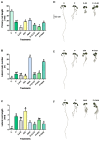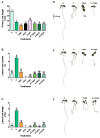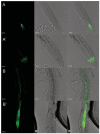The Steroid Saponin Protodioscin Modulates Arabidopsis thaliana Root Morphology Altering Auxin Homeostasis, Transport and Distribution
- PMID: 34451648
- PMCID: PMC8399103
- DOI: 10.3390/plants10081600
The Steroid Saponin Protodioscin Modulates Arabidopsis thaliana Root Morphology Altering Auxin Homeostasis, Transport and Distribution
Abstract
To date, synthetic herbicides are the main tools used for weed control, with consequent damage to both the environment and human health. In this respect, searching for new natural molecules and understanding their mode of action could represent an alternative strategy or support to traditional management methods for sustainable agriculture. Protodioscin is a natural molecule belonging to the class of steroid saponins, mainly produced by monocotyledons. In the present paper, protodioscin's phytotoxic potential was assessed to identify its target and the potential mode of action in the model plant Arabidopsis thaliana. The results highlighted that the root system was the main target of protodioscin, which caused a high inhibitory effect on the primary root length (ED50 50 μM) with morphological alteration, accompanied by a significant increase in the lateral root number and root hair density. Through a pharmacological and microscopic approach, it was underlined that this saponin modified both auxin distribution and transport, causing an auxin accumulation in the region of root maturation and an alteration of proteins responsible for the auxin efflux (PIN2). In conclusion, the saponin protodioscin can modulate the root system of A. thaliana by interfering with the auxin transport (PAT).
Keywords: allelopathy; auxin transport; natural herbicide; phytotoxicity; root morphology; saponin; specialized metabolites.
Conflict of interest statement
The authors declare that they have no conflict of interest.
Figures








Similar articles
-
Weisiensin B inhibits primary and lateral root development by interfering with polar auxin transport in Arabidopsis thaliana.Plant Physiol Biochem. 2019 Jun;139:738-745. doi: 10.1016/j.plaphy.2019.04.020. Epub 2019 Apr 16. Plant Physiol Biochem. 2019. PMID: 31010613
-
The allelochemical farnesene affects Arabidopsis thaliana root meristem altering auxin distribution.Plant Physiol Biochem. 2017 Dec;121:14-20. doi: 10.1016/j.plaphy.2017.10.005. Epub 2017 Oct 19. Plant Physiol Biochem. 2017. PMID: 29078092
-
Coumarin Interferes with Polar Auxin Transport Altering Microtubule Cortical Array Organization in Arabidopsis thaliana (L.) Heynh. Root Apical Meristem.Int J Mol Sci. 2021 Jul 7;22(14):7305. doi: 10.3390/ijms22147305. Int J Mol Sci. 2021. PMID: 34298924 Free PMC article.
-
Responses of the weed Bidens pilosa L. to exogenous application of the steroidal saponin protodioscin and plant growth regulators 24-epibrassinolide, indol-3-acetic acid and abscisic acid.Plant Biol (Stuttg). 2019 Mar;21(2):326-335. doi: 10.1111/plb.12927. Epub 2018 Dec 14. Plant Biol (Stuttg). 2019. PMID: 30341820
-
Ethylene inhibits lateral root development, increases IAA transport and expression of PIN3 and PIN7 auxin efflux carriers.Development. 2011 Aug;138(16):3485-95. doi: 10.1242/dev.065102. Epub 2011 Jul 19. Development. 2011. PMID: 21771812
Cited by
-
Metabolomics Mechanism and Lignin Response to Laxogenin C, a Natural Regulator of Plants Growth.Int J Mol Sci. 2022 Mar 10;23(6):2990. doi: 10.3390/ijms23062990. Int J Mol Sci. 2022. PMID: 35328410 Free PMC article.
References
-
- Chauhan B.S. Grand challenges in weed management. Front. Agron. 2020;1:3. doi: 10.3389/fagro.2019.00003. - DOI
-
- Monaco T.J., Weller S.C., Ashton F.M. Weed Science: Principles and Practices. John Wiley & Sons; Hoboken, NJ, USA: 2002.
-
- Clapp J. Explaining growing glyphosate use: The political economy of herbicide-dependent agriculture. Glob. Environ. Chang. 2021;67:102239. doi: 10.1016/j.gloenvcha.2021.102239. - DOI
-
- Heap I. International Herbicide-Resistant Weed Database. [(accessed on 26 February 2020)];2019 Available online: www.weedscience.org.
Grants and funding
LinkOut - more resources
Full Text Sources
Molecular Biology Databases

